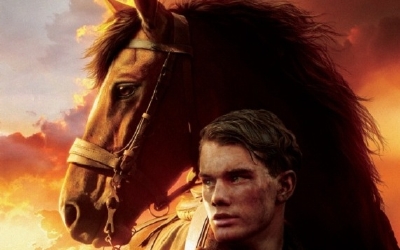War Horse: French 75 Cocktail Recipe 🥁🥁🥁🥁1/2
/Epic, Rousing, Heartfelt
Year Released: 2011
Directed by: Steven Spielberg
Starring: Jeremy Irvine, Emily Watson, Peter Mullan, Tom Hiddleston
(PG-13, 146 min.)

"If you have two loaves of bread, sell one and buy a lily." Chinese Proverb
Steven Spielberg reminds us once again what movie making is all about. His sweeping epic fills the screen with bigger than life action, drama, and heart-felt emotion that carry you away with it.
Yes, it’s set during World War I, one of the most cruel and senseless of wars, but strangely enough, the film is wrought with a kind of shining innocence, the kind that lights up the face of young Albert (newcomer Jeremy Irvine) when he first sets eyes on a new-born thoroughbred colt. It’s love at first sight, at least on Albert’s part, that same special "bromance" that united Roy Rogers with Trigger, the Lone Ranger with Silver, and young Alec with The Black Stallion.
Not only is the film set over a century ago, but it also recalls some of the values and sentiments we have put aside in this era seeped in cynicism and ironic detachment. There is nothing hip or edgy about War Horse. In fact, it is based on a 1982 children’s novel told through the point of view of the horse, much like the beloved 19th century classic, Black Beauty. It’s the kind of film that graced our theaters certainly through the forties and into much of the fifties, with a focus on human dignity, however flawed the characters. With the advent of the modern anti-hero, however, we came to focus on human foibles, to celebrate -- almost -- man’s fall from grace.
Spielberg abandons the snide humor so prevalent in many of his classic 80s features, such as ET and Goonies. No cutting comments about hapless adults or what your little brother’s breath smells of. No more puke-oramas after pie-eating contests, either. The film is as earnest as young Albert, as pure and stalwart as Joey, the thoroughbred he trains, a fact that apparently doesn’t go down all that well with certain film critics:
From the first scene of this WWI adventure, the director lays the schmaltz on so thick that it would be laughable if it wasn’t done so extremely well. Spielberg has never had any shame about using cinematic flourishes to tug the heart-strings, but here he sets a new personal bar for shamelessness.
All of this is frequently shot from a low angle and lit warmly from below, as though Spielberg dug the Ark of the Covenant out to help with the cinematography. –Jay Gabler
My only rejoinder is to quote Brendan Behan: “Critics are like eunuchs in a harem. They know how it’s done, they’ve seen it done every day, but they are unable do it themselves.”
The setting for the War Horse is significant, making it one of several intriguing 2011 films that recall earlier eras. Both Midnight in Paris and Hugo are set in Paris of the 1930s, While The Tree of Life recalls Waco, Texas of the 1950s, and Super 8, itself a tribute to Steven Spielberg, takes place in small town America of the late 1970s. Each of these remote times and places frees us to abandon our existing perspectives and see life through a new lens. War Horse takes us to another continent and century, to a war nearly none of us can recollect, thank goodness, since we can forget the political polemics that have marred the anti-war films belched out in rapid succession a few short years ago. Nobody has any ideological vendetta here, so we can view life in its more essential form.
In several arresting visual sequences Spielberg’s film captures a pivotal shift refiguring the world at that time, one even greater than the Great War itself. The natural world was slowly giving way to the mechanical world. One of the best images is a pure ode to joy, with Albert astride his Joey, racing down the lane along side the squire’s son, who is demonstrating the merits of his automobile to the sweet young thing seated next to him. When an exultant Albert flies by astride Joey, the two of them almost a single creature like a mythic centaur, no one can look away from this perfect package of youth, vigor, and masculinity. Suddenly, the shiny new automobile becomes a metal contraption as dull and awkward as the callow youth that drives it.
Another scene demonstrates the mechanical world in much more sinister terms. It pictures Joey, sold off to pay farm debts and now enlisted in the war, sloggging through the mud to pull a mammoth cannon up a hill. Finely boned, Joey is not bred for hard labor, but it’s that or sure death, since he has no other use in this dark chaos. His friend, the black giant, Topthorn, goes down, and we see horse corpses piled up in a mass grave that I must confess – it is a flaw and I know it -- hurts me as much or more than seeing images of human mass graves. I suppose that’s because these noble beasts have even less say in their future than the men swept up in this maelstrom.
Despite the dire events, we also see most men as essentially good and redeemable. Sure, there is the occasional brute – we can usually measure them by how they treat the horses – but most men are merely victims of inexorable forces, like war, poverty or the elements. Unlike the downtrodden Joads of Steinbeck’s The Grapes of Wrath, however, Spielberg’s characters struggle against their fate. Even as a father fails, as does Albert’s, his son takes up the struggle.
Albert’s father (Peter Mullan) and his mother as well, start out almost as clichés. He is the drunken, failed farmer who spends a fortune (30 guineas) on a young thoroughbred at auction instead of buying a suitable plow horse, as planned. But he is so taken by its beauty, he cannot resist - that and his pride at outbidding his preening landlord.
His wife (Emily Watson) seems at first a stereotypic shrew, berating her husband for his foolish purchase, but with a few brief scenes, we establish something deeper in each of them. She tells Albert that the tattered ribbons he finds in the barn were awarded to his father in another fruitless war, where he earned a crippled leg as well. Ribbons he has cast aside, since he earned them by killing. Even when his purchase of Joey puts the family on the verge of losing everything, Rosie Narracott does not totally condemn her husband. “I may hate you more, but I’ll never love you less,” she tells him.
So, for all its images of the carnage and chaos of war, essentially War Horse is romantic in nature. The great beauty and heart of the young stallion brings out the same in the humans he encounters, making them better for knowing him. Joey, that plain homespun name attached to such a magnificent creature is as understated as the tattered war ribbons Albert ties to his bridle when he must part with him. The young officer (Tom Hiddleston) who buys Joey, struck not only by the horse’s beauty but by Albert’s devotion as well, offers the boy some comfort. His purchase is not final, he says, since the stallion merits so much more than he can afford to pay for him. It is only a lease, and, Captain Nicholls promises he will, if he can, return Joey to Albert at the war’s end.
The captain is one of a long line of characters ennobled by their contact with Joey.
Emilie (Celine Buckens), a young French girl, hides Joey from the German troops in her bedroom of all places. Her curmudgeon of a grandfather (Niles Arestrup) softens to Joey as well and even allows his sickly grand daughter a whimsical gallop. Some of the Germans, certainly not all villains, also show Joey kindness. A particularly moving scene takes place in no man’s land, a scarred landscape of rotting corpses and vicious barbed wire set between the muddy trenches of the two opposing sides.
Bring the hankies and don’t be afraid to use them. You may even find yourself sobbing -- great, gulping, chest-heaving embarrassments-- as I did when I first saw Old Yeller.
—Kathy Borich

Film-Loving Foodie
Joey, our War Horse, is English born and bred, but the war takes him to France, where Albert, now a soldier, also finds himself. They become battle-hardened but never lose that spark of youth and innocence.
That may not be true for the rest of us, so we can feel free to indulge in this famous French cocktail that gets its name from this very same conflict. Our French 75 Cocktail is derived from the 75-millimeter M1897, a light, potent little gun with a vicious rate of fire, the mainstay of the French field artillery in World War I.
A votre santé!
French 75 Cocktail
The 75-millimeter M1897, a light, potent little gun with a vicious rate of fire, was the mainstay of the French field artillery in World War I. Hence the drink. Of all the many champagne-and-liquor combinations known to contemporary mixology, this one has the most élan. Two of these and you'd fight to defend Madonna's honor. The drink was a favorite of the Lost Generation -- hell, there's enough alcohol in it to give even Hemingway a buzz.
Most modern recipes lowball the gin; one online compendium cuts it down to 1/4 ounce. For shame. Nor should one adulterate this old soldier with Cointreau or the like. No shame, however, in leaving out the gin entirely -- as long as you replace it with brandy or cognac (yielding a King's Peg, although often recipes for these omit the lemon and sugar).
The Wondrich Take: Expert commentary from Esquire’s Resident cocktail historian.
Ingredients
2 ounces London dry gin
1 teaspoon superfine sugar
1/2 ounce lemon juice
5 ounces Brut champagne
Glass Type: Collins glass
Instructions
Shake well with cracked ice in a chilled cocktail shaker; then strain into a Collins glass half-full of cracked ice and top off with champagne.
Recipe Source: Esquire.com



















